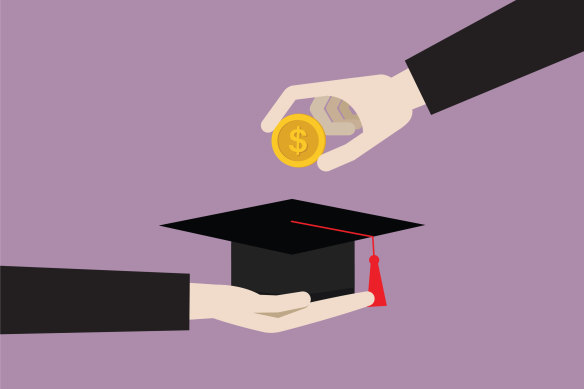Opinion
As a year 12 student, I dream of doing an arts degree. The price could be a lifetime of debt
Saria Ratnam
High school studentFifty thousand dollars of debt by the age of 21. That’s what it means to complete a bachelor of arts in Australia today under the government’s Jobs Ready Graduates scheme.
Currently, we’re in the midst of university application season. I’ve been working towards studying arts for two years, since I first really began contemplating what I would do when I finished year 12. But now as I’m preparing to submit my university preferences, the reality of how much debt I could be saddled with if I study arts has me leaning away and looking towards an area of study that I am not passionate about.

The cost of certain university degrees has got me rethinking what I should study.Credit: iStock
This dream-crushing policy, introduced by the Morrison government in 2021, is a sad indictment of our university system. It’s worth noting that this policy has failed on all fronts.
The Jobs Ready Graduates scheme doubled the price of most arts degrees while lowering the fees on other university course deemed to be more “useful”. It was intended to take a tough-love approach by diverting students away from arts and into high labour-demand fields such as nursing or teaching (where there have been shortages for decades), and other “national priority areas” including mathematical sciences and engineering.
However, it hasn’t worked. To date, a meagre 1.5 per cent of students have changed their higher education plans based on the scheme’s funding model, while data from the Universities Admissions Centre shows that in the past year alone first preferences for health and teaching dropped by 3.3 per cent and 19.2 per cent respectively.
At the same time, demand to study a bachelor of arts degree at the University of Melbourne is at its highest in five years, while Monash University, the University of Sydney and UNSW have all seen increased student rates of between 11 and 15 per cent, too.
Then there’s the issue of “national priority areas” and the fact many of them already seem obsolete. In the age of AI, jobs in mathematics and engineering are particularly vulnerable to being overtaken by technology. The skills gained by arts graduates – critical thinking, creativity and human interaction – are generally more adaptable and dynamic and can be applicable to a wider range of contexts.
Our growing polycrisis of interlaced societal problems demands complex and experimental thinking. That’s where humanities graduates – experts in war, history, gender studies, politics – become insightful policymakers.
This is not just speculation, either. Recent employability research shows the employment outcomes for arts and humanities graduates in Australia have risen by 15 per cent in a year – the most of any discipline. In 2023, eight out of 10 of the UK’s fastest-growing employment sectors hired humanities graduates above any other field.
Previously, degree prices were linked to expected future earnings. But since 2021, arts degree fees have become completely out of proportion. And since unpaid HECS is borne by the government, piling debt on top of a group that is likely to take longer to pay it off only puts more pressure on our economy.
The scheme also effectively asks arts students, who have lower average starting salaries than people in many other fields, to subsidise other degrees deemed to be of higher social value. Worse still, a large portion of humanities students are women and Indigenous people, meaning higher fees are being foisted onto two groups that are already economically disadvantaged.
The message this policy sends, inadvertently or otherwise, is that studying arts is a privilege, a fanciful pastime reserved for those who can afford it. And therein lies what is perhaps the worst aspect of the scheme: it denies how vital the arts are to society. The arts prioritise knowledge above vocation. The study of languages, literature, history, art – these things teach us how to be human and what it means to be human. This policy tells Australians those things don’t really matter.
In November 2022, just six months into taking office, the Labor government announced a major review of the existing Australian university model, including the Jobs Ready Graduates scheme. In its interim report, handed down in July 2023, the review panel made a point of noting “the continuation of these current arrangements risks causing long-term and entrenched damage to Australian higher education”. However, Labor has not committed to repealing the scheme.
For as long as this scheme is still in operation, year 12 students like me will be filling out their preference forms unsure of how much debt we’re signing up to. For arts, that could be a lifetime’s worth.
Saria Ratnam is a year 12 student living in Melbourne. She was highly commended in the 2023 Age/Dymocks Essay Prize for young writers.
The Opinion newsletter is a weekly wrap of views that will challenge, champion and inform your own. Sign up here.
Check out Campus, our higher education hub
- Feeling overwhelmed by uni applications? Here’s what year 12 students need to know
- Where Australia’s universities rank among the world’s best
- Here are five things I learnt from studying in Paris for six months
- Where to start when you don’t know what career you want